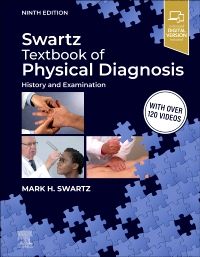● 이 책의 특징
Offering a compassionate, humanistic approach in this critical area, Swartz Textbook of Physical Diagnosis, Nineth Edition, helps you master each aspect of the art and science of interviewing and physical examination.
This highly regarded text clearly teaches how your interpersonal awareness is just as crucial during the patient interview and physical exam as your level of skill—and why clinical competence in this area is essential for physicians, osteopathic physicians, nurse practitioners, physician assistants, nurses, and all other members of the healthcare profession.
From cover to cover, you’ll learn fundamental skills and concepts that result in more accurate diagnoses, more effective patient management, and better patient outcomes.
Key Features
● Offers fully revised content throughout, including clear, easy-to-understand explanations of interviewing and examination techniques, clinical presentations, pathophysiology, complementary and alternative medicine, and physical diagnosis standards and tests
● Includes three new chapters: The Transgender Patient; Artificial Intelligence in Clinical Encounters: Opportunities and Challenges; and Telehealth:
Adapting Clinical Assessment
● Explores how cultural differences can influence communication, diet, family relationships, and health practices and beliefs—which may affect your approach to a patient’s treatment
● Features hundreds of high-quality
color images, an easy-to-use design, and detailed descriptions of practical techniques throughout
● Contains new end-of-chapter review questions in most chapters.
● Highlights clinical ethics and professionalism
● Includes more than 6 hours of
in-depth instruction, with 40+ updated videos featuring step-by-step aspects of the physical examination for adults, toddlers, and newborns, important interviewing scenarios, and audio of heart and lung sounds
● Features online appendices covering English-to-Spanish Translations Useful in the Medicine Setting, Commonly Misused Substances, Signs and Symptoms of Deficiency States, and more
● An eBook version is included with purchase. The eBook allows you to access all of the text and figures, with the ability to search, customize your content, make notes and highlights, and have content read aloud
Author Information
By Mark H. Swartz, MD, FACP, Professor of Medicine, State University of New York (SUNY), Downstate College of Medicine, Brooklyn, New York; Adjunct Professor of Medicine, New York Medical College, Valhalla, New York; Professor of Medical Sciences, New York College of Podiatric Medicine, New York, New York and Director, C3NY--Clinical Competence Center of
New York, New York, NY, USA
Section 01 Mastering the Art of Interviewing
01. The Interviewer's Questions
02. The Patient's Responses
03. Understanding Complementary and Alternative Medicine
04. Putting the History Together
Section 02 Valuing Diversity: Race, Gender, and Ethnicity
05. Anti-Racist and Anti-Oppressive Clinical Skills
Section 03 Understanding the Science of the Physical Examination
06. The Physical Examination
07. Assessment of Nutritional Status
08. The Skin
09. The Head and Neck
10. The Eye
11. The Ear and Nose
12. The Oral Cavity and Pharynx
13. The Chest
14. The Heart
15. The Peripheral Vascular System
16. The Breast
17. The Abdomen
18. Male Genitalia and Hernias
19. Female Genitalia
20. The Musculoskeletal System
21. The Nervous System
22. Putting the Examination Together
Section 04 Evaluating Specific Patients
23. The Pregnant Patient
24. The Pediatric Patient
25. The Geriatric Patient
26. The Transgender Patient
27. The Acutely Ill or Injured Patient
Section 05 Putting the Data to Work
28. Precision, Accuracy, and Critical Thinking in Clinical Assessment
29. The Clinical Record
30. The Focused History and Physical Examination
31. Artificial Intelligence in Clinical Encounters: Opportunities and Challenges
32. Telehealth: Adapting Clinical Assessment
Section 06 Analyzing Ethical Issues in Clinical Medicine
33. Clinical Ethics and Professionalism
Epilogue: A Journey Through Physical Diagnosis
Appendix A Answers to Review Questions
e-Appendices (Available Online)
E-Appendix B Commonly Misused Substances
E-Appendix C Signs and Symptoms of Deficiency States
E-Appendix D Conversion Tables
E-Appendix E English-to-Spanish Translations Useful in the Medical Setting
E-Appendix F The Rational Clinical Examination: Evidence-Based Clinical Diagnosis


